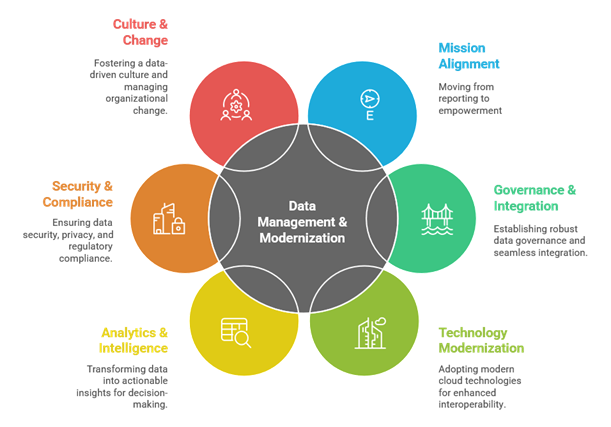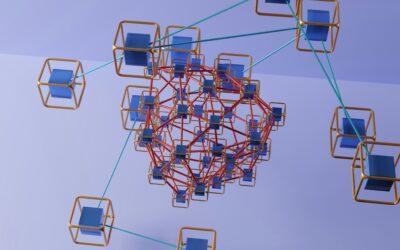Higher education in 2025 looks a lot different than it did just a few years ago. Colleges and universities are feeling the squeeze—declining enrollment, tighter budgets, and rising expectations from students who expect seamless, digital-first experiences.
At the same time, new technologies—yes, including AI and predictive modeling—are opening up incredible opportunities to reimagine how institutions operate.
But here’s the catch: transformation isn’t possible without strong data management and modern technology foundations. You can’t become a data-empowered institution if your data isn’t connected, trusted, and accessible.
That’s where the idea of the “Red Thread” comes in. It’s the throughline that connects governance, analytics, technology, and strategy into one shared purpose:
Empowering institutions to make trusted, data-driven decisions that improve student outcomes, operational efficiency, and agility.
Let’s look at how that Red Thread weaves through six key parts of modernization.
1. Mission Alignment: From Reporting to Empowerment
The Red Thread starts with mission alignment.
Historically, data reporting in higher education has centered on compliance—IPEDS submissions, accreditation, finance, and audits. Important work but often limited in scope. Too often, reports are created to meet a one-time operational need, serving a single department or leader. Over time, their value fades, offering little strategic insight as institutional priorities evolve. That’s not what true data-driven success looks like.
Real progress begins when data strategies align with the institution’s mission and have strong organizational sponsorship. Modern reporting expands that mission by shifting:
- From reporting what happened to understanding why it happened and predicting what’s next.
- From IT ownership to institution-wide data stewardship.
- From data as a byproduct to data as a strategic asset.
This evolution transforms reporting from a back-office function into a front-line driver of student success, equity, enrollment stability, and institutional trust. When alignment, access, and accountability come together, reporting becomes more than information; it becomes intelligence that empowers timely, trusted decisions.
2. Building the Foundation: Governance, Architecture, and Quality
Every modernization journey starts with a foundation you can trust with clear ownership, shared definitions, and solid data pipelines. If your data is scattered across systems or defined five different ways, you don’t get reliable dashboards. Instead, you get debates about which number is “right” before any real work begins. While the foundation may not be flashy, it’s a critical component of data management.
That means:
- Data governance frameworks – defining policies, stewardship roles, and metadata standards.
- Unified data architecture – bringing together SIS, LMS, CRM, HR, and finance data that used to live in silos.
- Data quality and lineage – ensuring accuracy, transparency, and accountability.
The Red Thread here is trust. Trust shows up as consistently applied definitions and clear lineage, so people believe the data they receive. When people trust the data, they use it to make better decisions. Leaders can stop arguing about data quality and start focusing on strategy. Finance and enrollment can work from the same plan. Faculty and staff can positively impact student outcomes. Ultimately, trust compounds: every visible win accelerates adoption of your data, which further fuels more data-empowered decision-making across campus.
3. Technology Modernization: Cloud, SaaS, and Interoperability
“Should I stay or should I go?” It’s not just a song lyric; it’s the question many institutions are asking as they weigh when and how to move from on-premises systems to the cloud. Higher education is steadily shifting toward SaaS-based solutions, cloud data environments, and integrated analytics ecosystems. The key is doing so in a way that preserves flexibility and ownership of institutional data.
Across campuses, modernization is taking many forms:
- Data warehousing with platforms like Snowflake, AWS, or Invoke Learning.
- Integration and automation through tools such as Python, Alteryx, and Invoke Learning’s ETL solutions.
- API-driven systems that allow campus applications to seamlessly exchange data.
The Red Thread here is agility—building scalable, secure, and cost-efficient systems that can evolve as institutional needs change. Data democratization is central to this evolution, ensuring that as institutions transition to hybrid or full-cloud environments, they retain the freedom to choose the right tools, vendors, and paths forward on their own terms.
4. Analytics and Intelligence: From Dashboards to Action
Traditional dashboards and reports still have their place. They help visualize data and track key metrics. But on their own, they can fall short of driving real change. Without unifying data across silos and making insights accessible to the right people, institutions risk basing decisions on an incomplete picture.
Today’s analytics landscape goes far beyond static dashboards. Colleges and universities are embracing:
- Predictive modeling to improve student retention, forecast enrollment, and boost advancement outcomes.
- Self-service tools like Evisions solutions that blend and democratize data access, giving more users the ability to explore and act on insights.
- AI and machine learning for personalized advising, smarter resource allocation, and continuous improvement.
The Red Thread connecting all of this is turning insight into action—transforming knowledge into tangible results for students, faculty, and staff. Success depends on aligning people, processes, and technology to ensure that everyone has data they can trust and tools that empower action.
5. Security, Privacy, and Compliance
With modernization comes new opportunities and new risks. As data moves beyond the traditional on-premises data center, institutions gain scalability and efficiency but must also navigate evolving threats and compliance demands.
Cloud adoption offers clear advantages: reduced capital costs, fewer maintenance burdens, and relief for overextended IT teams. Yet every institution moves at its own pace, shaped by unique needs and risk tolerance. The key is partnering with vendors who can meet you where you are—supporting your migration timeline while maintaining robust, well-architected controls for security, privacy, and higher ed compliance.
Institutions must continually balance:
- Access – empowering users with the information they need to make decisions.
- Compliance – meeting FERPA, GDPR, and HIPAA obligations.
- Security – safeguarding sensitive student, financial, and research data.
The Red Thread here is responsibility—driving innovation without compromising trust or ethical integrity. Modern partners must embrace best practices for PII management and operate with a zero data retention and zero trust mindset.
6. Culture and Change Management
Technology alone won’t modernize an institution — people will. True transformation happens only when there’s a collective commitment to building a data-driven culture. Without that, even the best tools fall short.
Winning teams focus on relationships, not just reports. They break down silos, establish shared governance, and build the trust needed to turn data into action. That means:
- Building data literacy across departments.
- Fostering shared ownership among IT, Institutional Research, Academic Affairs, and Student Services.
- Supporting data governance councils and communities of practice that keep progress sustainable.
The Red Thread here is people—empowering staff and faculty to use data confidently and collaboratively. Small wins matter. Celebrating early successes helps build momentum and encourages adoption. Over time, this culture of trust and empowerment enables staff to turn reliable data into meaningful insights—improving student success, operational efficiency, and the institution’s ability to fulfill its mission.
Stitching It All Together
The Red Thread of Data Management and Modernization isn’t just about systems or reports—it’s about creating a campus where data drives action, insight, and impact. 
It connects:
- Governance to Trust
- Technology to Agility
- Analytics to Insight to Action
- Culture to Adoption
- Mission to Impact
When these elements align, data stops being a back-office function and becomes a strategic asset—empowering faculty, staff, and leaders to make confident, timely decisions. The result? Stronger student outcomes, more efficient operations, and an institution truly capable of fulfilling its mission in a dynamic world.
Data isn’t just collected; it’s harnessed, trusted, and transformed into action. That’s the power of the Red Thread.
Moving Forward
This blog is just the beginning. Over the next few months, we’ll explore practical ways to strengthen your data management and modernization efforts—and share more about our own journey, including how we’re weaving AI into our platform.
Our goal is to be more than just a technology provider. We want to be your partner—helping higher ed leaders navigate the opportunities and challenges of data modernization thoughtfully, at your pace, and on your own course.


0 Comments
0 Comments